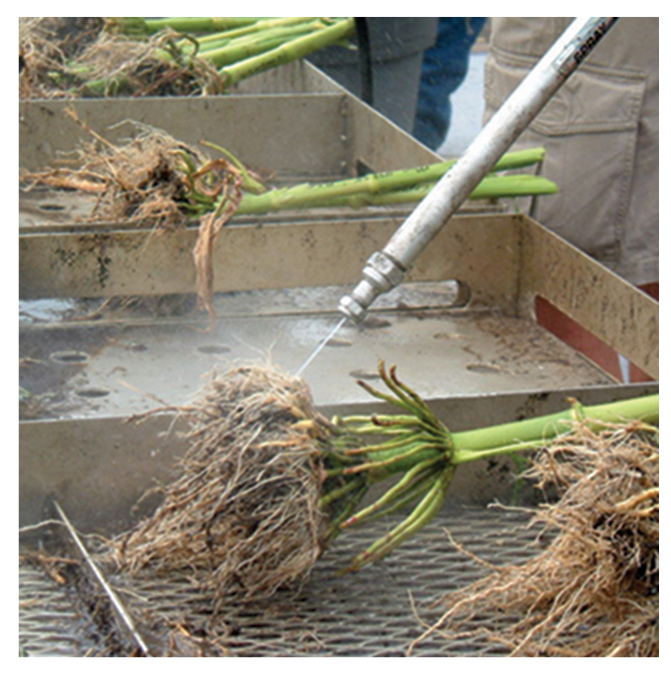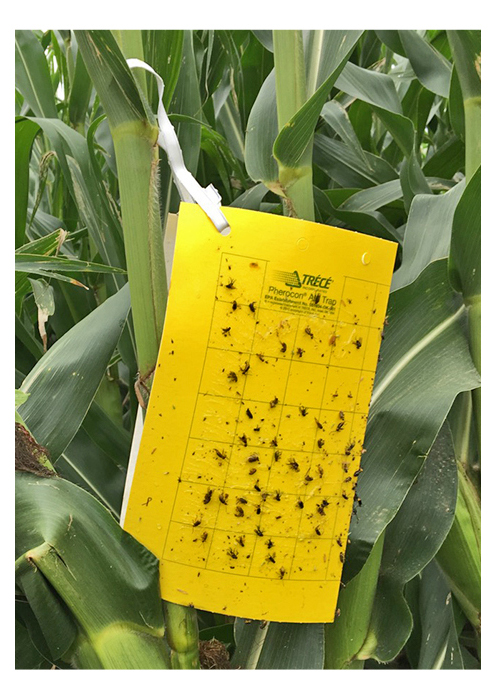Corn rootworms (CRW) are a significant threat to yield and profit throughout the Corn Belt. Corn rootworm pressure varies by year and conditions, but is somewhat predictable based on past CRW pressure and in-season observations.
There are many corn rootworm management practices available including CRW traits, soil applied insecticides, adult beetle control, crop rotations, or a combination of these practices. Understanding your risk level will help you choose the best corn rootworm management strategy for your acres to minimize risk and maximize profit. Two primary tools for monitoring CRW populations can help inform your decisions—digging roots and monitoring adult beetles.
Digging roots
Both western and northern CRW have only one generation per year. Eggs overwinter in the soil and hatch in late May and June. Root feeding begins as soon as they hatch, which usually happens about the same time lightning bugs appear. The heaviest root feeding occurs when rootworm larvae get bigger in mid-June and early-July. Digging roots allows you to assess root feeding or pruning, and assess how well your control program is working.
To assess root feeding:
1. Carefully dig up corn plants once the first adult CRW beetles are observed.
2. Gently tap plants on the ground to dislodge soil.
3. Wash the roots either by soaking in a bucket of water or using a pressure washer.
4. Assess root injury using the 0-3 nodal injury scoring system.
5. If <0.25 nodes are injured, your CRW management strategy is likely working.
6. Yield loss is possible when >0.25 nodes are injured, with more significant yield loss occurring when >0.75 nodes are injured. Some root regeneration can occur with adequate rainfall and good growing conditions.
CRW populations have been identified with resistance or cross-resistance to some of the current CRW traits, but it is hard to know how widespread this is. If you observe root feeding on hybrids with CRW traits, it can be hard to determine if root feeding was due to ineffectiveness of the trait or from being overwhelmed by large populations.

Monitoring Adult Beetles
Once larvae get big enough, they will pupate and emerge as adult beetles in July. Yellow sticky traps are helpful for scouting as the bright yellow color attracts the adult beetles. Wyffels monitors hundreds of corn fields throughout the Central Corn Belt each year. This information helps inform general trends in CRW populations, but the only way to make informed management decisions on your farm is to monitor your specific fields.
If you would like to participate in Wyffels’ corn rootworm monitoring program, you can sign up on the Wyffels website to receive all the materials you’ll need to monitor your fields. The process is pretty simple.
1. Begin placing traps by corn pollination. Position traps at least 120’ from the field edge.
2. Hang trap on a corn plant around ear height, and remove any leaves on that plant that may interfere with the trap.
3. For traps in soybean fields, hang them on a post just above the canopy.
4. Check traps weekly and record the number of beetles captured. Change out traps weekly if necessary.
5. Continue checking traps for 8 weeks, or until field exceeds 2 beetles per day, indicating CRW management will be needed for next year. Refer to the table on page 2 of this article for Wyffels’ CRW management recommendations.
If you wish to make a field specific CRW recommendation, a minimum of four well-spaced traps per field is recommended.

What about rotated acres?
First-year corn isn’t always “in the clear” anymore either. Certain segments of the CRW population have adapted around the corn-soybean rotation by an “extended diapause” (northern CRW) or the “soybean variant” (western CRW). Both variants can cause infestations in first-year corn and challenge the corn grower’s pest management plans, which is why it’s a good idea to be mindful of them as we plan for CRW monitoring.
Northern CRW extended diapause populations have adapted so eggs laid in corn delay hatch until the second year, when that field will likely be rotated back to corn. While there is no way to identify which northern CRW have adapted to extended diapause, it is a good idea to be mindful of how many northern CRW beetles you capture in corn fields you intend to rotate.
Western CRW soybean variant populations have adapted to lay eggs in soybean fields, which will then hatch the following year in what will likely be a corn field. In areas where the western variant may be suspected, it’s a good idea to place traps in soybean fields to monitor if CRW beetles are moving into soybean fields to feed and lay eggs.
Manage Risk and Maximize Profit
Understanding the risk of corn rootworm damage in your specific fields will help you make the best management decisions to minimize CRW damage and protect yield potential. CRW poses a significant risk to yield and profit potential if not managed properly, and have proven to be resilient to different management practices.
The days are gone where the only decision we have to make is what trait to use based on crop history, and this is no longer a decision that can be made blindly. Managing CRW involves gathering information and evaluating which tools are best for our situation. The use of CRW traits are one tool, but we must also consider the use of proven soil applied insecticides, adult beetle control, and crop rotation.

